WTI crude oil reaches as high as 64.48 so far as recent rally resumes. At this point, we’d still be expecting strong resistance inside 63.04/66.49 to limit upside to bring reversal. We’re not expecting break out from established range between 50.64/66.49 yet. However, firm break of 66.49 will bring upside acceleration to 100% projection of 42.05 to 66.49 from 50.86 at 75.29.
Gold gaps up as Middle East tension escalates, heading to 1625
Gold and oil prices surge as the week starts as Middle East tensions escalated further during the weekend. Iran quitted the nuclear deal and announced it’s no longer bounded by the agreement made in 2015. Iraq denounced US killing of the Iranian general in Baghdad as a violation of the nation’s sovereignty. Iraq’s parliament voted to expel US troops from the country. US President Donald Trump warned of strike to Iran “in a disproportionate manner” if the latter hits any US targets. He also threatened to sanction Iraq if US troops were forced to withdraw from the country.
Gold gaps higher today and hits as high as 1587.92. Break of 1557.04 resistance confirms resumption of up trend from 1160.17. Further rise should be seen to 61.8% projection of 1266.26 to 1557.04 from 1445.59 at 1625.29. As noted before, rise form 1445.59 could be the fifth leg of the five-wave sequence from 1160.17. We’d look for topping signal around 1625.29. However, sustained break of 1625.29 will bring upside acceleration to 100% projection at 1736.37.
ISM manufacturing dropped to 47.2, lowest since 2009
ISM Manufacturing Index dropped to 47.2, down from 48.1, missed expectation of 48.5. That’s the lowest reading since June 2009. Looking at some details, new orders dropped -0.4 to 46.8. Production dropped -5.9 to 43.2. Employment dropped -1.5 to 45.1.
Timothy Fiore, Chair of ISM Business Survey Committee: “Global trade remains the most significant cross-industry issue, but there are signs that several industry sectors will improve as a result of the phase-one trade agreement between the U.S. and China. Among the six big industry sectors, Food, Beverage & Tobacco Products remains the strongest, while Transportation Equipment is the weakest. Overall, sentiment this month is marginally positive regarding near-term growth.”
German CPI accelerated to 1.5%, beat expectations
German CPI rose 0.5% mom in December, above expectation of 0.3% mom. Annually, CPI accelerated to 1.5% yoy, up from 1.1% yoy, beat expectation of 1.4% yoy.
Unemployment rose 8k to 2.279m in December, more than expectation of 0k. The rise in unemployment was also the highest Since May. Unemployment rate was unchanged at 5.0%, slightly above record low of 4.9% recorded earlier in 2019. Labor Office head Detlef Scheele said that “the weak economic cycle is leaving visible marks”.
UK PMI construction dropped to 44.4, but Brexit clarity could deliver boost ahead
UK PMI Construction dropped to 44.4 in December, down from 45.3, missed expectation of 45.7. The index has been below the 50 no-change mark for the eighth consecutive month. It’s the longest period of contraction for almost a decade. Markit added there was the sharpest fall in civil engineering activity since March 2009. New business decreased for the ninth month in a row. Input cost inflation eased to the lowest level since February 2010.
Tim Moore, Economics Associate Director at IHS Markit, which compiles the survey:
“December data suggested that the UK construction sector limped through the final quarter of 2019, with output falling in all three major categories of work. Brexit uncertainty and spending delays ahead of the General Election were once again the most commonly cited factors highlighted by firms experiencing a drop in construction activity.
“Civil engineering saw its sharpest decline for more than ten years and remained the worst-performing area of construction work, followed by commercial development. House building has been the most resilient category in recent months, but still declined overall during December.
“The forward-looking survey indicators provide some hope that the construction sector malaise will begin to recede in the coming months. Latest data indicated that the downturn in order books remains much less severe than the low point seen last August, which has already helped to bring employment numbers closer to stabilisation.
“Moreover, construction companies signalled that business optimism has recovered to its strongest for nine months. Survey respondents cited confidence that a more predictable domestic political landscape and clarity on Brexit could deliver a much-needed boost to clients’ willingness-to-spend in 2020.”
Gold to break 1557 resistance as up trend resumes
Gold’s rally accelerates today and reaches as high as 1545.34 so far. Escalation in Middle East tensions is the main driving force behind safe haven flow into gold.
Medium term up trend looks ready to resume with focus now on 1557.04 resistance. Break will confirm this bullish case and target 61.8% projection of 1266.26 to 1557.04 from 1445.59 at 1625.29. On the downside, break of 1516.58 support will delay the bullish case and extend the consolidation pattern from 1557.04 with another fall first.
Also, as the current rally could be the fifth leg of the five-wave sequence from 1160.17. We’d look for topping signal around 1625.29.
PBoC official said China has room to cut RRR further
In an article, a PBoC official said that adjustment in the reserve requirement ratio was for providing “long-term, stable liquidity” to the real economy. It’s not a sign towards loose monetary policy. The article was first published in December, released again by the China Bond magazine via it’s Wechat account yesterday. that came a day after PBoC announced fresh RRR cut on Wednesday.
Ruan Jianhong, head of the Statistics and Analysis Department at the People’s Bank of China (PBOC), said, “from an international perspective, China’s current required reserve ratio (RRR) is still relatively high and has relatively big room to adjust”. Along with other monetary policy tools, RRR adjustments “can provide long-term, stable liquidity to the real economy.”
“In recent years, PBOC has been reducing RRRs successively. But this doesn’t mean PBOC is shifting toward a looser monetary policy. Rather, the moves are aimed at supplementing liquidity to the overall economy in an efficient, low-cost manner,” She added.
Oil surges after Iranian top general killed by US air strike
WTI oil price surges sharply and breaches 63.04 resistance. Recent rally accelerates abruptly on news that US air strike killed top Iranian commander, Qassem Soleimani, the general who led the Revolutionary Guards’ Quds force. “This strike was aimed at deterring future Iranian attack plans,” the Pentagon said in a statement. Ahmed al-Assadi, a spokesman for Iraq’s Popular Mobilisation Forces (PMF) said “the American and Israeli enemy is responsible for killing the mujahideen Abu Mahdi al-Muhandis and Qassem Soleimani.”
There is no clear follow through buying above 63 handle yet. As WTI will enter into key resistance of 63.04/66.49 on the next rise, we’ remain cautious on topping there. Meanwhile, break of 60.46 support will be a sign of rejection by the mentioned resistance zone. In this case, WTI should then at least have a pull back to 55 day EMA (now at 58.43).
Yen surges on falling treasury yields
Yen surges in early US session with USD/JPY breaking key near term support of 108.27. US stock opened higher but are now trading off highs. Though, major indices are still in black and that’s likely not the reason for the rally in Yen. Instead, the sharp fall in treasury yield is likely what’s behind the move.
At the time of writing, US 10-year yield is down -0.0552 at 1.865. The break of 1.87 near term support now opens up the way for 1.7 handle.
Canada PMI manufacturing dropped to 50.4, disappointing end to 2019
Canada PMI Manufacturing dropped to 50.4 in December, down from 51.4, hitting a four-month low. Markit noted there was slower output growth amid fall in new orders. Subdued rate of job creation continued. Also, Business optimism dropped to its weakest since February 2016.
Commenting on the PMI data, Tim Moore, Economics Associate Director at IHS Markit said:
“December data revealed a disappointing end to 2019 for the Canadian manufacturing sector as the steady recovery in production volumes stalled, while new orders fell back into decline.
“Weakness in the investment goods category linked to softer capital spending at home and abroad remained a key factor behind the subdued manufacturing trend. Consumer goods producers once again fared better than elsewhere in the industrial sector, but even this outperforming area reported a growth slowdown at the end of 2019.
“It appears that manufacturers are braced for a lack of new work to replace completed projects in the New Year, with business optimism now at its lowest for almost four years and job creation moving closer to stagnation in the latest survey period.”
US initial jobless claims dropped to 222k, slightly below expectation
US initial jobless claims dropped -2k to 222k in the week ending December 28, slightly below expectation of 225k. Four-week moving average of initial claims rose 4.75k to 233.25k.
Continuing claims rose 5k to 1.728m in the week ending December 21. Four-week moving average of continuing claims rose 7.25k to 1.712m.
UK PMI manufacturing finalized at 47.5, took a turn for the worse
UK PMI Manufacturing was finalized at 47.5 in December, down from November’s 48.9. It’s the second weakest level for almost seven-and-a-half years (the PMI stood at 47.4 in August 2019). Also, the index has posted below the neutral mark of 50.0 in each of the past eight months.
Rob Dobson, Director at IHS Markit, which compiles the survey:
“The UK manufacturing sector took a turn for the worse at the end of 2019. Output fell at the quickest pace in seven-and-a-half years as new order inflows decreased and Brexit safety stocks were reduced. With demand weak and confidence remaining subdued, input purchasing was pared back sharply and jobs cut for the ninth successive month.
“The downturn is still being hardest felt at companies reliant on investment and business-to-business spending. The steepest reduction in output was at investment goods producers, as continued uncertainty meant new orders and new export business suffered the steepest contractions in over a decade. Intermediate goods producers also experienced marked drops in output and new work received. There was a pocket of growth, however, as consumer goods production edged higher. On this basis, it looks like UK manufacturing and the broader economy may both start the new decade as they began the last, too reliant on consumer spending and still waiting for a sustained improvement in investment levels.”
Eurozone PMI manufacturing finalized at 46.3, a dire end to 2019
Eurozone PMI Manufacturing was finalized at 46.3 in December, down from November reading of 46.9. Markit noted there were accelerated falls in both output and new orders. Also, there was prevalence of spare capacity that led to further job losses.
Looking at the member states, Germany PMI Manufacturing was finalized at 43.7, a two month low. Italy and and the Netherlands dropped to 80-month lows at 46.2 and 48.3 respectively. France reading dropped to 3 month-low of 50.4.
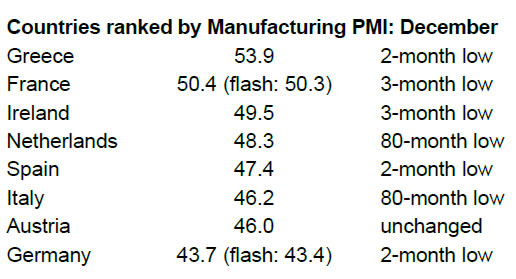 Commenting on the final Manufacturing PMI data, Chris Williamson, Chief Business Economist at IHS Markit said:
Commenting on the final Manufacturing PMI data, Chris Williamson, Chief Business Economist at IHS Markit said:
“Eurozone manufacturers reported a dire end to 2019, with output falling at a rate not exceeded since 2012. The survey is indicative of production falling by 1.5% in the fourth quarter, acting as a severe drag on the wider economy.
“Although firms grew somewhat more optimistic about the year ahead, a return to growth remains a long way off given that new order inflows continued to fall at one of the fastest rates seen over the past seven years. Firms sought to reduce inventory levels and cut headcounts as a result, focusing on slashing capacity and lowering costs. Such cost cutting was again also evident in further steep falls in demand for machinery, equipment and production-line inputs.
“Only households provided any source of improved demand in December, underscoring how the consumer sector has helped keep the economy out of recession in recent months. The ability of the wider economy to avoid sliding into a downturn in the face of such a steep manufacturing contraction remains a key challenge for the eurozone as we head into 2020.”
China Caixin PMI manufacturing dropped to 51.5, room for recovery with trade deal
China Caixin PMI Manufacturing dropped to 51.5 in December, down from 51.8, missed expectation of 51.7.
Zhengsheng Zhong, Director of Macroeconomic Analysis at CEBM Group said: “China’s manufacturing economy continued to stabilize in December, although the expansion in demand was not as strong as the previous two months. Positive changes included improved business confidence, and strengthened willingness to increase production and inventories, which are beneficial to the job market. Subdued business confidence was a major factor behind the economic slowdown this year. As the phase one trade deal between China and the U.S. has sent out positive signals, there is room for a recovery in business confidence, which should be able to help stabilize the economy.”
China cuts RRR by 50bps, releasing CNY 800B in funds
China’s PBoC announced yesterday to cut the reserve requirement ratio (RRR) by 50bps to 12.5%, effective January 6. That’s the eight cuts since early 2018, for releasing more funds for lenders to support the slowing economy. The reduction is expected to release around CNY 800B (USD 115B) of long term liquidity. Also, the move would offset cash demand ahead of Lunar New Year, keeping the liquidity of the banking system stable.
Outlook seemed to have improved recently as data showed stabilization. Meanwhile, China is expected to sign the phase one trade deal with the US, likely on January 15. Yet, more support measures are still expected as growth would likely cool further in 2020.
US consumer confidence dropped to 126.5, little to suggest consumer spending will gain momentum
Conference Board US Consumer Confidence dropped slightly to 126.5 in December, down from upwardly revised 126.8, missing expectation of 128.0. Present Situation Index rose from 166.6 to 170.0. Expectations Index dropped from 100.3 to 97.4.
“Consumer confidence declined marginally in December, following a slight improvement in November,” said Lynn Franco, Director of Economic Indicators at The Conference Board. “While consumers’ assessment of current conditions improved, their expectations declined, driven primarily by a softening in their short-term outlook regarding jobs and financial prospects. While the economy hasn’t shown signs of further weakening, there is little to suggest that growth, and in particular consumer spending, will gain momentum in early 2020.”
Trump announces to sign China trade deal phase one on Jan 15
US President Donald Trump announced in Twitter that he’s going to sign the phase one trade with with China on January 15. White House will be the location, with high level representatives of China present. Though, there was no mentioning of Chinese President Xi Jinping.
Trump added that he will go to Beijing at a later date to kick start phase two negotiations.
China CFETS lowers Dollar weighting in RMB index, increase Euro weighting
Starting on January 1, US Dollar’s weighting in the China Foreign Exchange Trade System (CFETS) RMB Index would be lowered. CFETS is overseen by the PBoC and the RMB index measures the value of Yuan against a basket of 24 major currencies, with weights based on international trade.
After the adjustment, Dollar’s weighting will be lowed from 22.4% to 21.59%. Euro’s weighting will be increased from 16.34% to 17.40%. CFETS said the adjustment was to make the index more representative, taking into account trade data from 2018.
China PMI manufacturing unchanged at 50.2, non-manufacturing dropped to 53.6
The official Chinese PMI Manufacturing was unchanged at 50.2 in December, slightly above expectation of 50.1. PMI Non-Manufacturing dropped to 53.5, down from 54.4, missed expectation of 53.6.
Special analyst Zhang Liqun said there was signs of stabilization but “foundation still needs to be consolidated”. Also “efforts should continue to be made to implement the various policies and measures to achieve the “six stability” and to strengthen the foundation for economic stability as soon as possible.
Wen Tao of Logistics Information Center noted the effect of release of market demand during the holidays. Also, there are productions of consumer goods ahead of Chinese New Year.




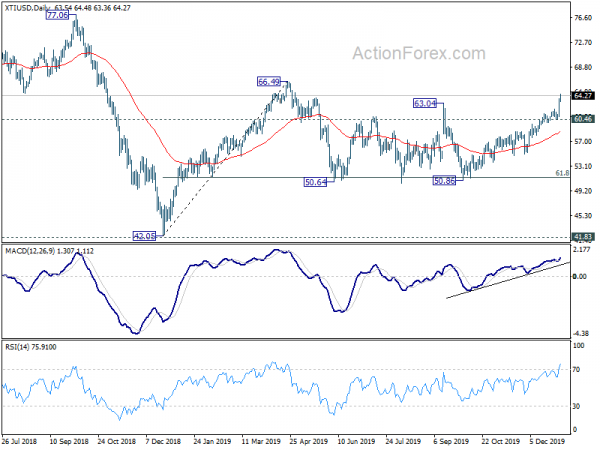
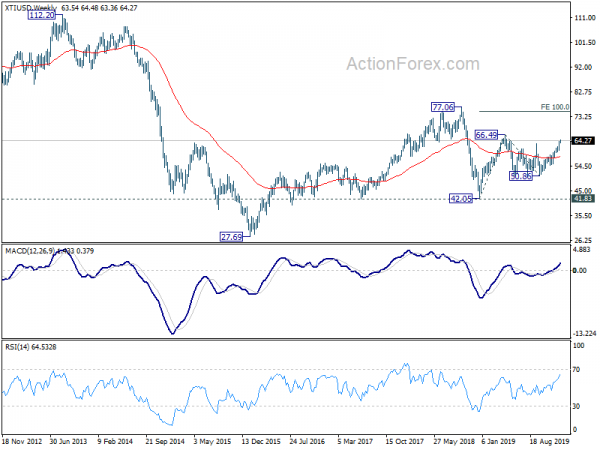
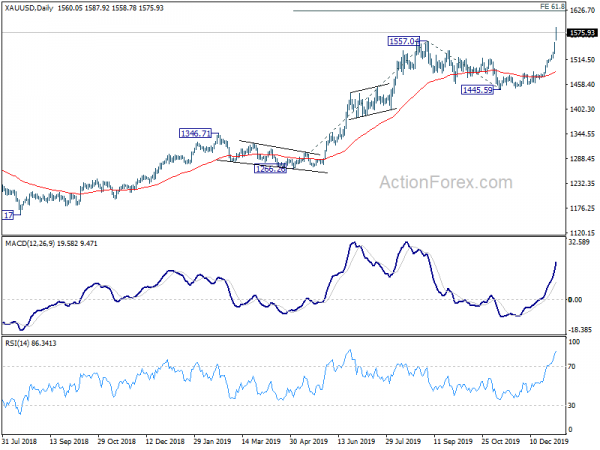
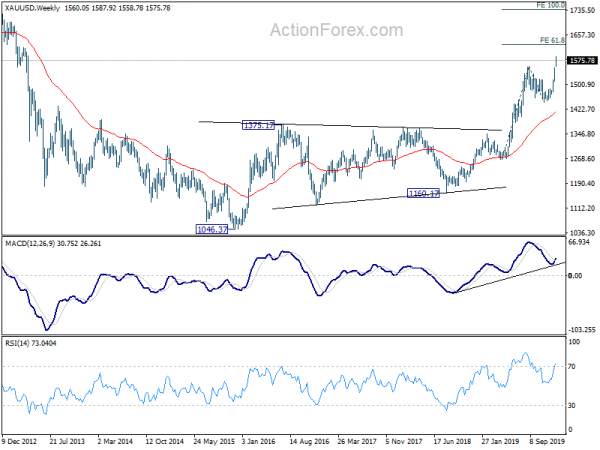
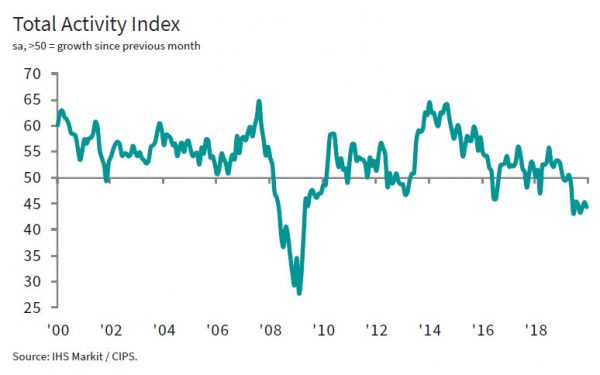


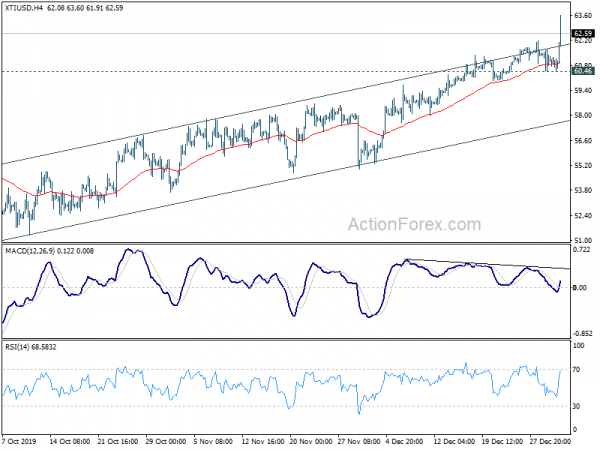
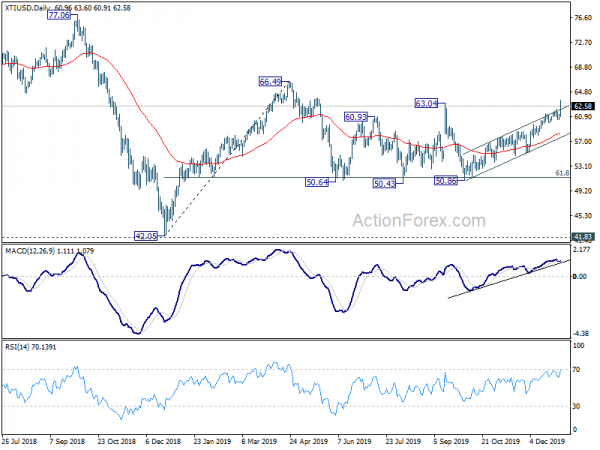
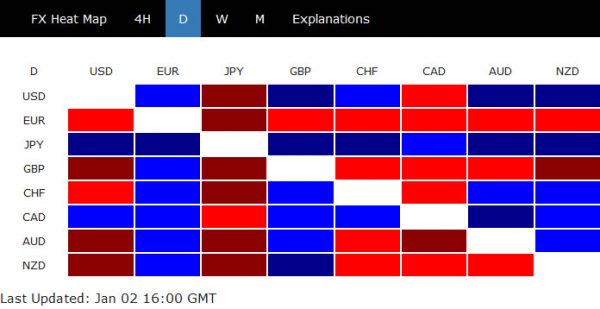
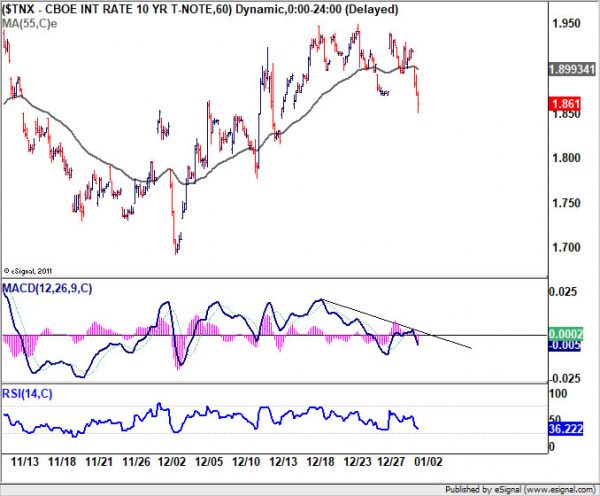
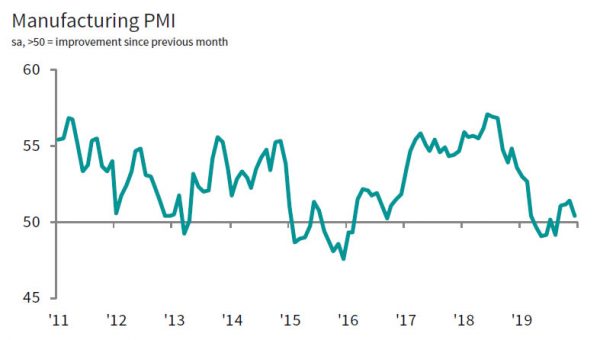
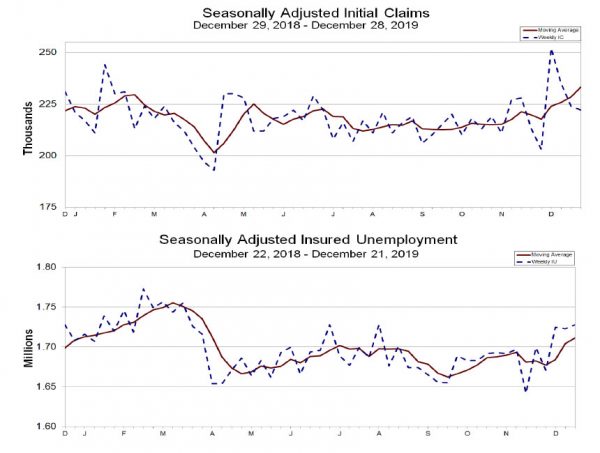
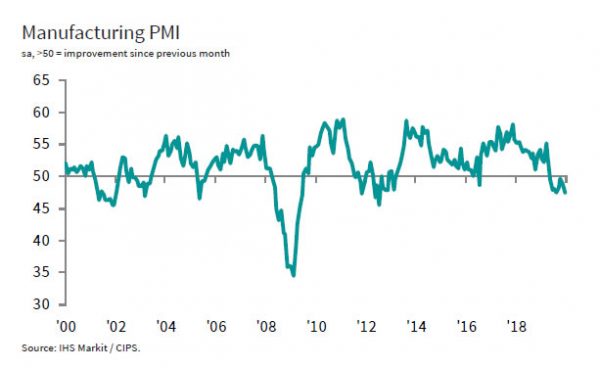
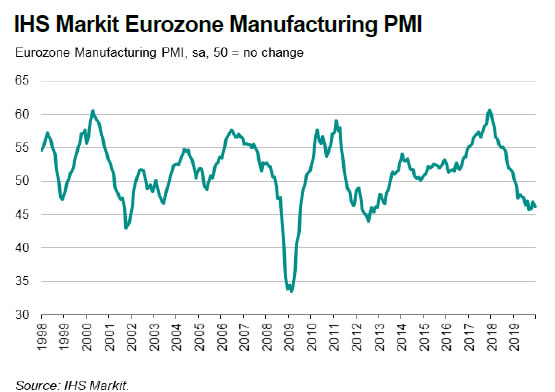
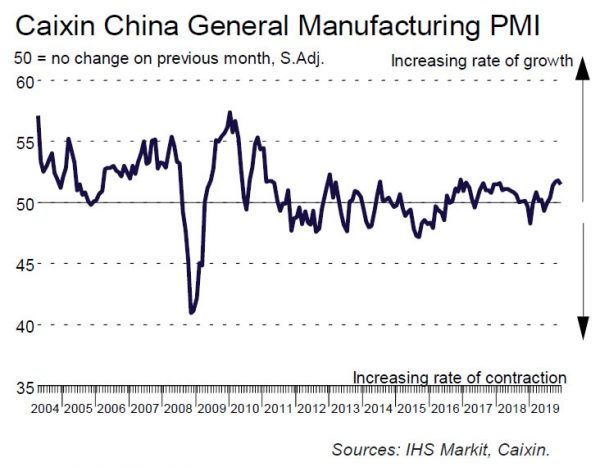


Williams: Fed has to stick to 2% inflation target
New York Fed President John Williams told WSJ that it’s important for Fed to stick to its 2% inflation target. Fed has to make sure inflation expectations don’t slip too far, which will affect actual inflation in the future.
“There’s been a process of going through the stages of grief about a low neutral rate,” he said. “These factors are basically the hand we’ve been dealt for the next five to 10 years.”
He warned “if inflation continues to underrun our target levels like it has, this downward trend in inflation expectations will likely continue with inflation expectations falling well below target levels.”